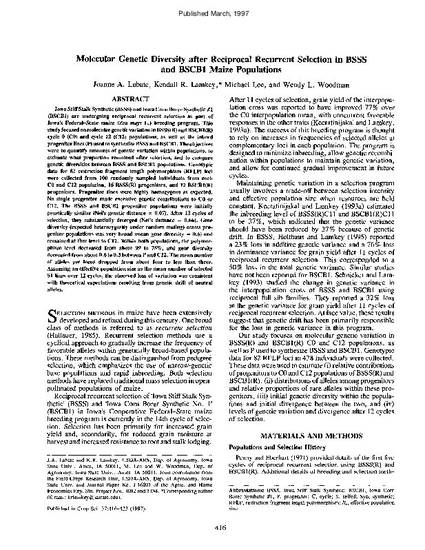
Iowa Stiff Stalk Synthetic (BSSS) and Iowa Corn Borer Synthetic #1 (BSCB1) are undergoing reciprocal recurrent selection as part of Iowa's Federal-State maize (Zea mays L.) breeding program. This study focused on molecular genetic variation in BSSS(R) and BSCBI(R) cycle 0 (CO) and cycle 12 (C12) populations, as well as the inbred progenitor lines (P) used to synthesize BSSS and BSCB1. The objectives were to quantify amounts of genetic variation within populations, to estimate what proportion remained after selection, and to compare genetic diversities between BSSS and BSCB1 populations. Genotypic data for 82 restriction fragment length polymorphism (RFLP) loci were collected from 100 randomly sampled individuals from each CO and C12 population, 16 BSSS(R) progenitors, and 12 BSCBI(R) progenitors. Progenitor lines were highly homozygous as expected. No single progenitor made excessive genetic contributions to CO or C12. The BSSS and BSCB1 progenitor populations were initially genetically similar (Nei's genetic distance = 0.07). After 12 cycles of selection, they substantially diverged (Nei's distance = 0.66). Gene diversity (expected heterozygosity under random mating) across progenitor populations was very broad (mean gene diversity = 0.6) and remained at that level to C12. Within both populations, the polymorphism level decreased from about 99 to 75%, and gene diversity decreased from about 0.6 to 0.3 between P and C12. The mean number of alleles per locus dropped from about four to less than three. Assuming an effective population size as the mean number of selected S1 lines over 12 cycles, the observed loss of variation was consistent with theoretical expectations resulting from genetic drift of neutral alleles.
Available at: http://works.bepress.com/kendall_lamkey/57/

This article is published as Labate, Joanne A., Kendall R. Lamkey, Michael Lee, and Wendy L. Woodman. "Molecular genetic diversity after reciprocal recurrent selection in BSSS and BSCB1 maize populations." Crop Science 37, no. 2 (1997): 416-423. doi: 10.2135/cropsci1997.0011183X003700020018x. Posted with permission.